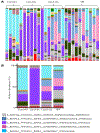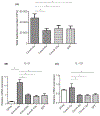Establishment of oral bacterial communities in germ-free mice and the influence of recipient age
- PMID: 28776953
- PMCID: PMC6525632
- DOI: 10.1111/omi.12194
Establishment of oral bacterial communities in germ-free mice and the influence of recipient age
Abstract
The acquisition of the oral microbiome is a complex process. We examined how the timing of microbial exposure alters bacterial colonization of the tooth surface. Germ-free mice were conventionalized by exposure to specific pathogen-free (SPF) mice to acquire a commensal microbiome over three distinct 4-week periods, 0-4 weeks of age (Conv0-4w), 4-8 weeks (Conv4-8w), or 8-12 weeks (Conv8-12w). Bacterial DNA was extracted from the tooth surface and analyzed by 16S rDNA sequencing. Total bacteria and inflammatory cytokine expression in gingiva were determined by quantitative real-time polymerase chain reaction. After co-housing with SPF mice, Conv0-4w and Conv4-8w mice had low bacterial diversity, whereas Conv8-12w mice had high bacterial diversity that was similar to that of SPF donor mice, as determined by both operational taxonomic units and the Shannon Index. Cluster analysis with unweighted Unifrac distance also supported these trends. This was surprising as the amount of maturation time, 4 weeks, was equal in all conventionalized mice and tooth eruption was largely completed by 4 weeks. This suggests that host factors that occur after tooth eruption have a significant effect on the microbial tooth colonization.
Keywords: 16S rDNA; age; gnotobiotic mice; inflammatory response; oral microbiota; sequencing.
© 2017 John Wiley & Sons A/S. Published by John Wiley & Sons Ltd.
Figures





References
-
- Shoemark DK, Alen SJ. The microbiome and disease: Reviewing the links between the oralmicrobiome, aging, and Alzheimer’s disease. J Alzheimers Dis. 2015;43:725–738. - PubMed
-
- Schindler D, Gutierrez M, Beineke A, et al. Dendritic cells are central coordinators of the host immune response to Staphylococcus aureus bloodstream infection. Am J Pathol. 2012;181:1327–1337. - PubMed
Publication types
MeSH terms
Substances
Grants and funding
LinkOut - more resources
Full Text Sources
Other Literature Sources

